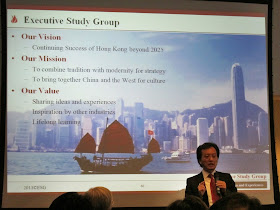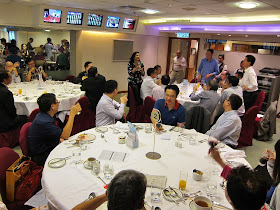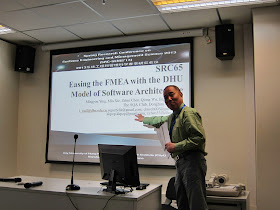The May topic of Executive Study Group (ESG) named “Leadership Strategy – How to Engage Customer and Employees through Social Media” which was held by the Executive Study Group (ESG), Chinese University of Hong Kong (CUHK) and the Hong Kong Science and Technology Parks Corp (HKSTPC) on 24 May 2013. I would like to summarize the seminar for sharing below.
Dr. Mark Lee introduced the seminar included "Mega Trends", "Three Elements of Successful Social Strategy", "Establishing New Relationships (新相識)", "Strengthening Existing Relationships (舊相好)", "Connecting with Friends and with Strangers", and "Group Discussion".
In the beginning, Dr. Mark Lee explained social media gave a chance for people communication and satisfied their need such as Facebook with The Rubber Duck in Hong Kong recently. Moreover, people could participate your product design such as Pepsi - DEWocracy. For General Electric, CEO used GE Colab, which designed by GE employees to facilitate global teamwork, to share his ideal weekly.
Then Dr. Lee told us "Don't Import Digital Strategies into Social Environments". Social Media was not a website but a platform to connect with other people. The following diagram showed the different between digital and social strategies.
Three Elements of Successful Social Strategy was introduced. Dr. Lee quoted Prof. Mikolaj Jan Piskorski (Harvard Business School) social strategies:
1. By helping people establish or strengthen relationships
2. If they do free work on a company's behalf
3. Finally reduce cost or increase customers' willingness to pay.
Based the Social Strategy, it separated into social impact (Establish Relationships and Strengthen Relationships) and strategy impact (Reduce Cost and Increase Willingness to Pay). There were four ways to pursue social strategies:
- Reduce costs by helping people meet
- Increase willingness to pay by helping people meet
- Reduce costs by helping people strengthen relationships
- Increase willingness to pay by helping people strengthen relationships
There were four samples in the table and each company represented their position of social strategies.
In Yelp case, many volunteers contributed free food review to the platform called Yelpers. (It liked "Openrice" in Hong Kong. (One -way)) The most passionate and prolific Yelpers would be invited to join the Elite Squad. Moreover, Squal membership gave them accessed to exclusive Yelp-hosted events (Two-way). It was not only online activities but also offline activities. It was found that average elite Yelper would produce about 100 more reviews than a nonelite. It could be summarized that social strategy of Yelp allowed the best contributors to meet like-minded people. If contributors wrote reviews, it could help the company obtained quality content for free.
In American Express case, OPEN credit cards targeted small business owners and launched OPEN Forum. They also launched a members-only social network called Connectodex. It provided a platform for service offer and need, as well as freely connected for business. It was not like LinkedIn (many professionals), Connectodex members usually were small business bosses / owners. The member was not only customer, but also referral. The social Strategy summary was helping SME owners to meeting others like them. If members would like to maintain their card membership, they would increase willingness to pay American Express.
In Zynga case, the company provided free social games in Facebook including Farm Ville and City Ville. The game presented players with obstacles such as limits on number of plots or businesses they was able to possess. In order to overcome the obstacles, player could pay with virtual goods they bought from Zynga or asked their friends to help through Facebook status updates or Zynga's messaging system. The social strategy was allowing people to reconnect with friends. If they invited them to return to the game, it could reduce acquisition and retention costs of customer.
In eBay case, they joined with Facebook to provide Group Gifts Online Application that people used to pool funds to buy gifts for their common friends. Group gifts helped people purchased better-targeted and more expensive gifts than they might otherwise. Its strategy allowed people to strengthen their friendships through gift giving. If they asked their friends to buy from eBay, it increased willingness to pay.
Dr. Lee said the major pitfall of business was that company focused on their business goals but paid less attention to customer's unmet social needs. After that Dr. Lee raised a case study from XCard and showed us the four formulas of social strategy. Before discussed the XCard strategy, we needed to do a excise to select two of the most difficult social strategies and one of the easiest social strategy.

After discussion, Dr. Lee explained XCard social utility test. For social need of women executive, invitation-only events for them to capitalize on their heavy travel schedules were not. For social need of Moms, it was no edge for Moms and large retailers of children's products such as Toys "R" Us or Walmart, could create a more effective platform. For Gift giving, people would hesitate to use a program from credit card because of privacy issue risk. For Shopping with Friends, it leveraged the card's superior rewards program and invited 10,000 customer for pilot test. They encourage the users to post a Facebook status update after shopping. Moreover, customer informed others that all involved would received additional XCard rewards for coshopping.
Finally, Dr. Lee refreshed the vision, mission and value of Executive Study Group. The group was formed in 2008 after economic crisis. It aimed to assist Hong Kong industry upgrading their management skill at that time.
Reference:
The Centre for Logistics Technologies and Supply Chain Optimization, CUHK -
http://www.logitsco.cuhk.edu.hk/HKSTP -
www.hkstp.org


















































